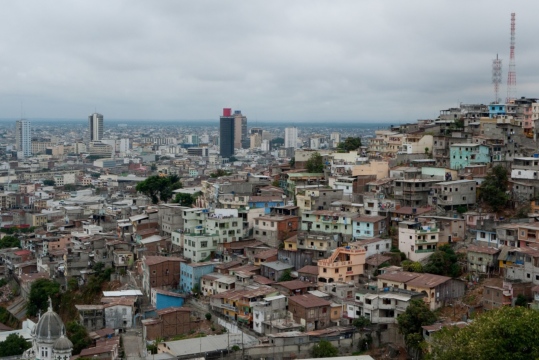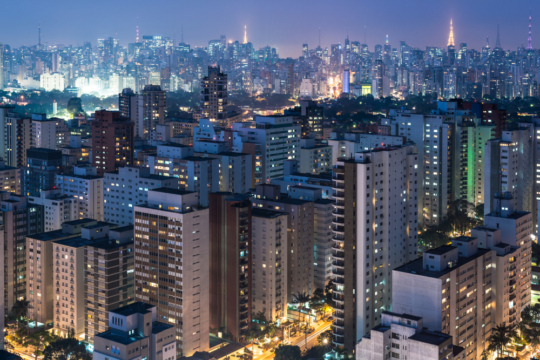 By Jaana Remes, a partner of the McKinsey Global Institute and a member of the Latin America Advisor’s board of advisors
By Jaana Remes, a partner of the McKinsey Global Institute and a member of the Latin America Advisor’s board of advisors
Cities matter in Latin America more than just about anywhere else on earth. Four-fifths of the region’s population already lives in urban areas—a much higher share than in any other part of the world except for North America. Just 10 large cities generate a third of the region’s GDP.
But Latin America’s leading cities have a legacy challenge. Population growth has outstripped their ability to deliver infrastructure and services, creating daily stress from issues like gridlock, crime and pollution. The region’s cities have run headlong into constraints that leave them unable to live up to their potential as engines of economic growth and productivity for the broader region.
Latin American cities have to figure out how to deliver more for less. Harnessing data and digital technology can help them meet that challenge. Consider what some other cities around the world have achieved with “smart” technologies. By installing air quality sensors, Beijing was able to track specific sources of pollution and act on the problems; in less than a year, the Chinese capital had reduced deadly airborne pollutants by around one-fifth. Faced with some of the worst traffic gridlock in the world, Moscow decreed in 2011 that infrastructure projects and transit management would be guided by data and complemented by the launch of an intelligent transport system. Impressively, although the city has added a million private cars since 2010, average travel speeds have increased by 13 percent.
But how exactly does a smart city work? It’s not just a top-down project, or lots of flashy touchscreens on the streets. It’s an urban ecosystem in which many different actors use data and digital technologies to make better decisions, solve public problems and achieve a better quality of life. The degree and mix of private-sector participation varies from city to city, depending on local choices.
Individuals play an active role, too. When a company sees a revenue-producing opportunity to offer an on-demand van service, residents in underserved neighborhoods suddenly have a new way to get to work. When a resident looks at real-time traffic data and decides to set out at a less busy time, she avoids adding another car to the road that would worsen congestion for everyone. Millions of individual decisions and actions add up, making the whole city more productive and responsive.
The McKinsey Global Institute (MGI) recently assessed how dozens of current smart city applications could perform in cities with different infrastructure systems and starting points. We found that cities can do a lot to save lives, improve security and reduce diseases. They can make the air healthier to breathe and make big strides in conserving energy and water.
Perhaps nothing affects the urban quality of life more than the daily commute. MGI found that smart mobility innovations can shorten the average commute by 15–20 percent. That could give the average worker 15 to 30 minutes of their day back, with some people benefitting much more.
Around the world, public safety affects every urban resident’s peace of mind—and this is particularly true in the Latin American capitals where homicide rates rank among the highest in the world. We estimate that security applications and a more data-driven approach to policing could reduce assaults, robberies and auto thefts by 30 to 40 percent. Optimizing dispatch systems and traffic lights for first responders can get them to the scenes of crimes, fires and medical emergencies 20–35 percent faster, often shaving off five to 10 valuable minutes to help people get emergency care when it can still be effective. Using a range of security and mobility applications could prevent as many as 300 deaths a year from homicide, fire and traffic accidents.
Today, cities around the world are moving forward with dozens of these types of tools. But MGI’s snapshot of worldwide deployment showed that major Latin American cities are lagging behind their global peers—most notably in building out foundational high-speed communication networks and sensors. In terms of specific applications, the region has some notable leaders. Rio de Janeiro is out in front on security applications, for instance, and Santiago is ahead of many peers in infectious disease monitoring and telemedicine. Yet many holes remain. There are big uncaptured opportunities to improve mobility through predictive maintenance and digital payments in public transit and intelligent traffic management.
Cities across Latin America have an opportunity to jump-start progress. A lot of it is up to local governments and city agencies—but not all of it. Governments don’t have to provide every type of application and service themselves. It’s helpful to think of a smart city as an ecosystem. There’s room for companies and nonprofits and partnerships to innovate, with local governments coordinating all the activity. MGI finds that the public sector would be the natural owner of 70 percent of the applications it considered, but 60 percent of the initial investment could come from private actors.
The key is to start from a thorough understanding of the problems residents face and a determination to tackle those problems first. With those priorities in mind, cities can find the smart tools that will enable them to invest less and get better outcomes—and these tools often empower residents to be part of the solution by helping with their choices and behavior. Technology can’t solve every urban problem, but it can make a big difference if it is firmly embedded into broader strategies for making a city great.
Editor’s note: See also a summary and webcast of the Dialogue’s Sept. 11 event in Washington on smart cities in Latin America and the Caribbean.























